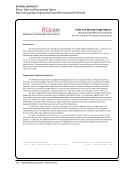84 · Survey Results: Survey Questions and Responses
Some materials are restricted to university-only access because they are student-related records, have copyright
restrictions, etc. Some records held by the Medical Center Archives contain PHI and are protected under the HIPAA
Privacy Rule and the HIPAA Security Rule.
Some materials may be restricted as a result of policies and/or regulations, or donor agreements.
Some materials *may* be restricted to non-community users, perhaps. As of now, everything is open to everyone and
we will try to keep that status as long as we can.
Some material may be restricted to on-campus use only (i.e., in library or reading room) or to members of the campus
community (i.e., faculty, staff, students).
The dark archive is accessible to library staff only. Born-digital materials have the same access restrictions as their analog
predecessors. Graduate school policy resists open access to ETDs. Researchers deny open access to data collections.
The format of the records has not changed who we make records available to. Our standard user categories (i.e.,
university staff, researchers, etc.) still apply.
The restrictions would be the same as we have for paper records—restrict personnel or student-related data, donor
restrictions.
The same restrictions that apply to paper documents will apply to born-digital materials. We have a five-page access
policy governing these issues that I cannot restate here.
There are internal policies relating to personnel, such as university personnel records containing personal information.
University records are restricted for a set time period and then open to the public. However, the creating office has
access to the records during the restriction period. The restrictions vary depending on the nature of the creating office.
We also have some collections that are restricted based on donor request.
University records are restricted to certain staff. Some manuscript collections carry restrictions to certain categories of
users. However, most collections are open to all users.
User category.
User category and institutional affiliation.
Varying restriction periods on certain types of records (institutional records, personnel, student) and potential other
restrictions per individual gift agreements.
We embargo some resources, such as ETDs and research data, at the request of the student or faculty member. These
embargoes generally represent a desire to finish a research project, publish a book or article on the findings, etc. We will
also restrict parts of a research project indefinitely if the data has privacy issues.
All born-digital materials are available to all users
All content is available to all users however, not all content is available on the web.
As a public institution, institutional records are available for public scrutiny within certain exceptions outlined in law.
Any other restrictions would be dictated by donor agreements. There are no uniform restrictions, and we have such a
minimal amount of born-digital materials right now there are not any identifiable categories.
Copyright and university policy are the main restrictions for the content we have collected to date.
Some materials are restricted to university-only access because they are student-related records, have copyright
restrictions, etc. Some records held by the Medical Center Archives contain PHI and are protected under the HIPAA
Privacy Rule and the HIPAA Security Rule.
Some materials may be restricted as a result of policies and/or regulations, or donor agreements.
Some materials *may* be restricted to non-community users, perhaps. As of now, everything is open to everyone and
we will try to keep that status as long as we can.
Some material may be restricted to on-campus use only (i.e., in library or reading room) or to members of the campus
community (i.e., faculty, staff, students).
The dark archive is accessible to library staff only. Born-digital materials have the same access restrictions as their analog
predecessors. Graduate school policy resists open access to ETDs. Researchers deny open access to data collections.
The format of the records has not changed who we make records available to. Our standard user categories (i.e.,
university staff, researchers, etc.) still apply.
The restrictions would be the same as we have for paper records—restrict personnel or student-related data, donor
restrictions.
The same restrictions that apply to paper documents will apply to born-digital materials. We have a five-page access
policy governing these issues that I cannot restate here.
There are internal policies relating to personnel, such as university personnel records containing personal information.
University records are restricted for a set time period and then open to the public. However, the creating office has
access to the records during the restriction period. The restrictions vary depending on the nature of the creating office.
We also have some collections that are restricted based on donor request.
University records are restricted to certain staff. Some manuscript collections carry restrictions to certain categories of
users. However, most collections are open to all users.
User category.
User category and institutional affiliation.
Varying restriction periods on certain types of records (institutional records, personnel, student) and potential other
restrictions per individual gift agreements.
We embargo some resources, such as ETDs and research data, at the request of the student or faculty member. These
embargoes generally represent a desire to finish a research project, publish a book or article on the findings, etc. We will
also restrict parts of a research project indefinitely if the data has privacy issues.
All born-digital materials are available to all users
All content is available to all users however, not all content is available on the web.
As a public institution, institutional records are available for public scrutiny within certain exceptions outlined in law.
Any other restrictions would be dictated by donor agreements. There are no uniform restrictions, and we have such a
minimal amount of born-digital materials right now there are not any identifiable categories.
Copyright and university policy are the main restrictions for the content we have collected to date.










































































































































































































